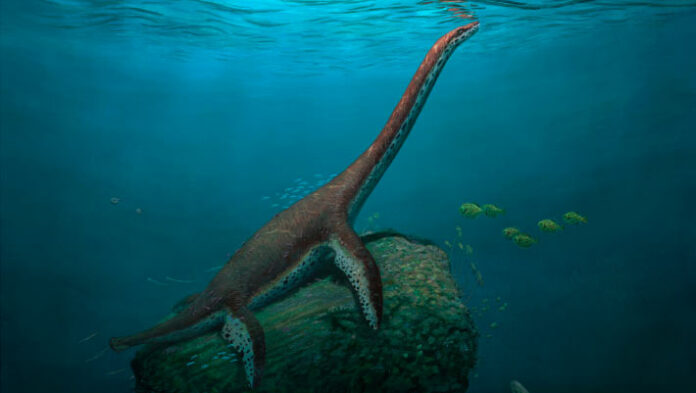A new genus and species of plesiosaur that lived near the onset of the Early-Middle Jurassic turnover has been identified from two exquisite, three-dimensionally preserved skeletons found in Bavaria, Germany.
Franconiasaurus brevispinus lived in the Early Jurassic seas approximately 175 million years ago.
The ancient reptile was a member of Plesiosauroidea, a group of plesiosaurs known from the Jurassic and Cretaceous periods.
“Plesiosaurs are Mesozoic reptiles fully adapted to an aquatic lifestyle,” said Sven Sachs from the Naturkunde-Museum Bielefeld and colleagues.
“Throughout their evolutionary history exceeding 140 million years plesiosaurs dispersed globally, achieved substantial diversity, occupied a variety of ecological niches, and experienced multiple faunal turnovers.”
“Of those, the Early/Middle Jurassic transition event (175 to 171 million years ago) has recently became of increased interest because it apparently profoundly affected all three major lineages of plesiosaurs: Rhomaleosauridae, Pliosauridae and Plesiosauroidea.”
“This event apparently markedly affected several clades of marine tetrapods, including ‘fish-like’ ichthyosaurs, marine crocodile relatives (thalattosuchians), as well as all three major lineages of plesiosaurs.”
“The predatory plesiosaur clade Rhomaleosauridae that dominated in Early Jurassic seas started to disappear, meeting its final demise around 161.5 million years ago (Late Middle Jurassic), while Pliosauridae and Plesiosauroidea diversified.”
“Pliosaurids established a successful clade of macropredators that had regulated the upper tier of marine ecosystems from 171 to 90 million years ago and comprised some of the largest aquatic predatory tetrapods that have ever lived, with forms exceeding lengths of 10 m.”
“Plesiosauroids, in turn, switched from microcleidid-rich communities common for Toarcian European epeiric seas to cryptoclidid faunas that represented the globally dominant plesiosauroid components in the Middle and Late Jurassic until they were replaced by leptocleidians and elasmosaurids near the Jurassic-Cretaceous transition.”

Diagnostic skeletal elements of the type specimen of Franconiasaurus brevispinus. Image credit: Sachs et al., doi: 10.3389/feart.2024.1341470.
Two fossilized skeletons of Franconiasaurus brevispinus were found in a now-abandoned clay-pit, part of the Jurensismergel Formation, in Mistelgau, Bavaria, Germany.
“Franconiasaurus brevispinus is established based on two exquisite, three-dimensionally preserved specimens,” the paleontologists said.
“The holotype includes a largely complete skeleton which, however, lacks most of the skull.”
“The referred specimen represents a larger individual and comprises vertebrae, ribs, and some girdle and limb elements.”
Franconiasaurus brevispinus displays a mixture of features that combine characters almost uniformly distributed among early plesiosaurs with those typically observed in later members of the clade.
“Phylogenetic analyses firmly place Franconiasaurus brevispinus as the sister taxon to Cryptoclidia, bridging an evolutionary gap between early plesiosauroids, such as Plesiosaurus-like forms and microcleidids, and later-diverging representatives of the clade, such as cryptoclidids, leptocleidians, and elasmosaurids,” the researchers concluded.
Their paper was published online in the journal Frontiers in Earth Science.
_____
Sven Sachs et al. 2024. Exquisite skeletons of a new transitional plesiosaur fill gap in the evolutionary history of plesiosauroids. Front. Earth Sci 12; doi: 10.3389/feart.2024.1341470


